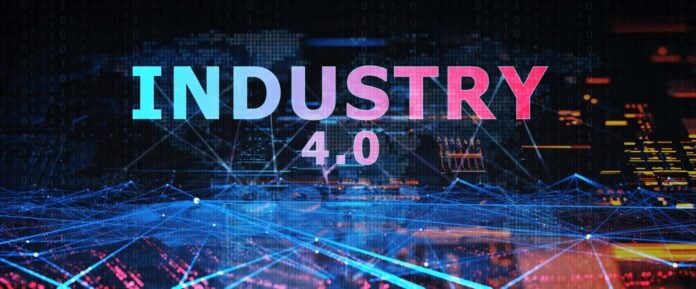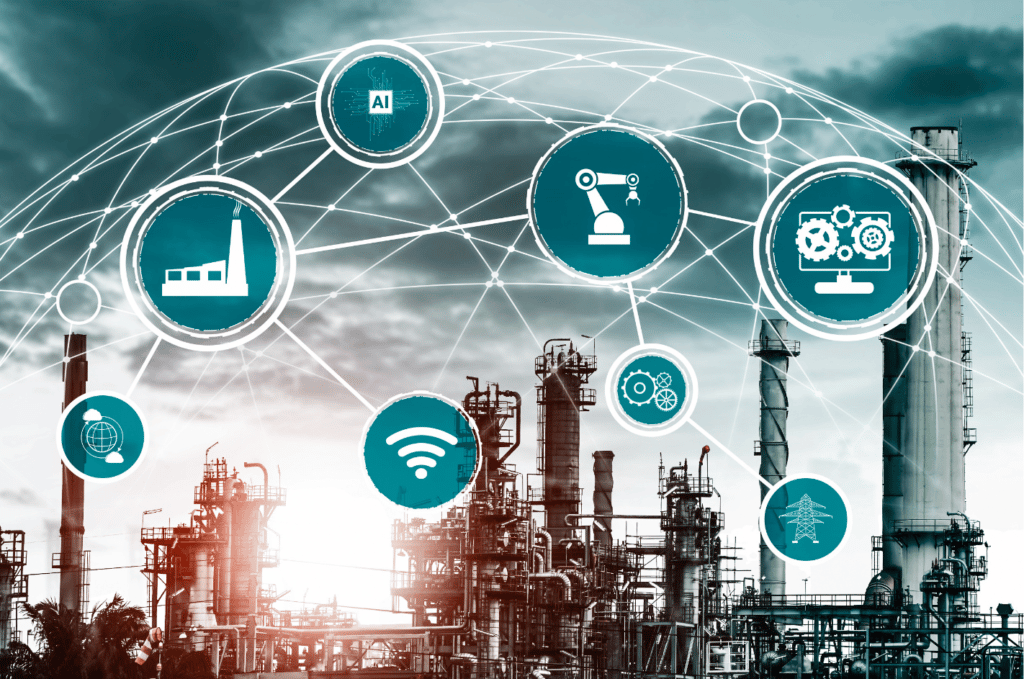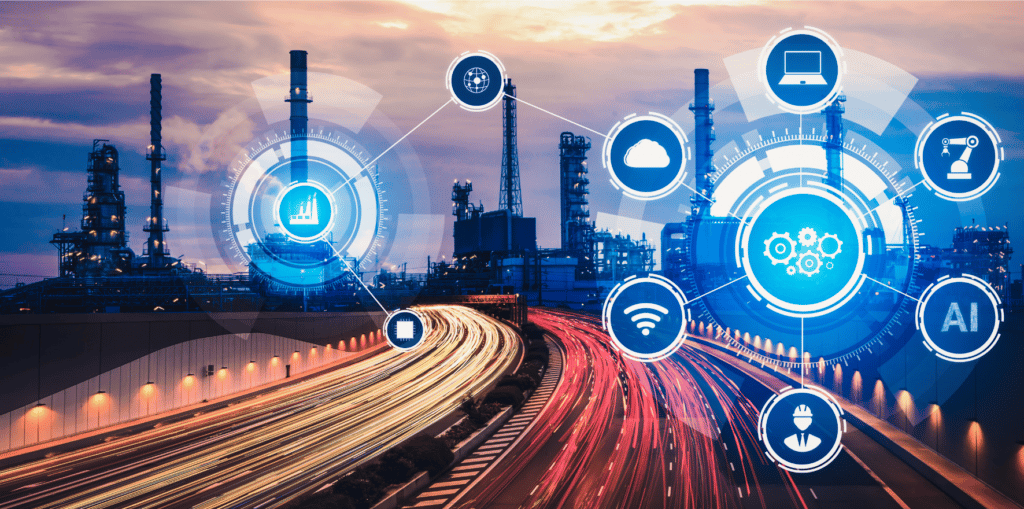The world around us has fundamentally changed and right now it’s happening again for the fourth time. This time it’s all about data and automation that are going to be blurring the lines between the physical and digital worlds.
That’s what we call ‘industry 4.0’. It’s where all of our devices from our wearable technology are all going to be constantly sharing information between themselves. Wearable technology such as smart cars, homes, and computers.
One of the defining factors of this industrial revolution will be the heavy use of robotics, and we have already started to see that play out. Grocery stores all over the world are relying more and more on self-checkout kiosks.
It’s predicted that by 2040 all cars on the road will be driverless and Tesla has already announced a humanoid service robot to help with chores around the house. It’s also predicted that over half of all the current jobs we have will be gone by 2055.
Many people believe that, when that time comes, half the world will be unemployed with no real way to generate income.

Industrial Revolution History
The transition from creating goods by hand to machine production was known as the Industrial Revolution. Scholars disagree much about when it began and ended, although the time frame mainly covered the years 1760 to 1840.
Some claim that this historical turning point is to blame for the rise in population, rise in living standards, and development of the capitalist system. Because of its significant influence on people’s daily lives, the Industrial Revolution has been referred to as the most profound revolution in human history.
The word “industrial revolution” is a brief way to sum up a historical era that began in Great Britain in the 18th century. It was marked by an apparent acceleration of progress. Numerous new tools and machines were created as a result of the speeding up of technological innovation processes.
Additionally, it encompassed more subtle practical advancements in a number of areas that had an impact on resource consumption, labor, and production. Both of those aspects of invention are included in the concept of “technology,” which is derived from the Greek word techne, which means art or craft.
In the history of humanity, we have gone through 3 industrial revolutions that have transformed our modern society. 3 industrial revolutions (plus the fourth industrial revolution) explained as follows:
The steam engine
The most recognizable invention of the Industrial Revolution is the steam engine, which can be used independently or as a component of a train. By the middle of the nineteenth century, experiments from the seventeenth century had evolved into a technology that propelled massive factories, allowing for deeper mines and a transportation system.
Steam was embraced surprisingly slowly, especially given its renown in the so-called Industrial Revolution, which is generally believed to have started around 1750. According to historians like Deane, the engine had minimal impact at first since it could only be used for large-scale industrial activities, the bulk of which were small-scale until 1830.
She acknowledges that some industries, like the iron and coal industries, used it, but claims that the majority only found the capital investment to be worthwhile after 1830 due to the difficulty of hiring and firing manual labor compared to a steam engine, delays in the development of viable engines, and high initial costs.
The Age of Science and Mass Production
A handful of significant inventions caused things to accelerate. Consider automobiles, aircraft, and chemical fertilizers. All of these advancements made it possible for us to work more quickly.
However, scientific advances weren’t just made in the lab. The factories immediately adopted scientific concepts. Especially noteworthy was the assembly line, which efficiently drove large manufacturing.
Early in the 20th century, Henry Ford’s business was mass producing the revolutionary Ford Model T, a car with a gasoline engine constructed in his factories using an assembly line. People move to where the jobs are, and in the early 1900s, workers were moving from their rural homes to metropolitan regions and factory positions.
Electric lights, radio, and telephone developments changed how people communicated and lived together with the rise in urbanization.
The rise of digital technology
The third industrial revolution—the digital revolution—began in the 1950s and brought with it semiconductors, mainframe computing, personal computing, and the Internet. The transition from analog electrical and mechanical equipment to mainstream digital technology has had a significant impact on various industries, particularly the global communications and energy sectors.
Due to advancements in electronics and computer technology, production began to become automated, and supply networks became worldwide.
The Fourth Industrial Revolution
The most recent industrial revolution spawned from the rise of digital technology; the computer, internet, smartphones, etc. Right now it’s happening again for the fourth time but this time it’s all about data and automation that are blurring the lines between the physical and digital world where all of our devices are smarter, faster, and deeply integrated into every aspect of our lives.
There are a few key technologies that are going to dominate this revolution and change everything about the way we live. Each of these first three industrial revolutions represented profound change. People moved from the countryside into towns as a result of the introduction of mechanical production, which shifted life’s primary focus from the farm to the factory.
The invention of electricity and the advent of mass production drastically altered the way people lived and worked. And most recently, the digital revolution affected almost every industry, changing people’s lives, places of employment, and modes of communication once more.
Also read: What is Supermarket Software and Why do Stores Need It?
Technologies That Navigate Industry 4.0
-
Internet of Things
All of our devices are getting smarter like smart TVs, smart cars, smart speakers, and smartphones. Being smart just means that they can connect themselves to the internet, and soon enough it’s going to be applicable to everything.
That’s what we call the Internet of Things. These gadgets include anything from common domestic items to high-tech industrial gear. On the manufacturing floor, machines have sensors with IP addresses that enable them to communicate with other web-enabled devices. Large-scale valuable data collection, analysis, and exchange are made possible by this mechanization and connection.
-
Cloud computing
Cloud computing, in general, is the delivery of hosted services over the internet. Infrastructure as a Service (IaaS), Platform as a Service (PaaS), and Software as a Service are the three main categories or types of cloud computing into which these services fall (SaaS).
A cloud can be either public or private. Anyone online can purchase services from a public cloud. With specific access and authorization settings, a private cloud is a proprietary network or data center that offers hosted services to a small group of users. Cloud computing’s objective, whether it’s private or public, is to offer simple, scalable access to computer resources and IT services.
A key component of any Industry 4.0 plan is cloud computing. The connectivity and integration of engineering, supply chain, production, sales and distribution, and service are necessary for the full realization of smart manufacturing.
The cloud makes that feasible. For small- and medium-sized manufacturers who can appropriately assess their demands and scale as their firm grows, cloud computing can significantly lower startup costs.
-
AI and machine learning
AI is the ability of a computer to perform humanlike tasks and replicate human thinking and behavior. It refers to intelligence systems that can recognize objects, solve problems, and perform other actions that a human could.
It does so by focusing on the following five areas: learning, reasoning, problem-solving, language and perception. Manufacturing firms can fully benefit from the abundance of information created not just on the factory floor but also across all of their business units, as well as from partners and outside sources, thanks to AI and machine learning.
AI and machine learning can produce insights that give operations and business processes visibility, predictability, and automation. For instance, industrial machinery frequently breaks down while producing a product. Businesses can do machine learning-based predictive maintenance using data gathered from these assets, increasing uptime and efficiency.
-
Edge computing
Edge computing is a new computing paradigm that refers to a range of networks and devices that are at or near the user. Edge is about processing data more quickly and in larger volume near the point of generation.
It also provides action-driven solutions in real-time. It offers specific unique characteristics compared to traditional models, which have processing power centralized at an on-premise data center.
This reduces the amount of time between the production of data and the need for a response. Depending on how reliable the network is, it may take too long to transport data from the manufacturing floor to the enterprise cloud and back.
Manufacturing firms have not traditionally given cybersecurity or cyber-physical systems much thought. The same operational equipment (OT) connectivity that makes industrial processes more efficient also opens up new entry points for unwanted attacks and malware. It is crucial to take into account a cybersecurity strategy that includes both IT and OT equipment when undergoing a digital transformation to Industry 4.0.
-
Digital twin
A digital twin is a virtual representation made to accurately replicate a physical object. A wind turbine, for example, has several sensors attached to it. These sensors generate information about a variety of performance characteristics of the physical device, including energy output, temperature, environmental conditions, and more.
Manufacturers can now construct digital twins, which are virtual clones of processes, production lines, factories, and supply networks, thanks to Industry 4.0’s digital transformation.
The creation of a digital twin requires the collection of data from IoT sensors, devices, PLCs, and other web-connected objects. Digital twins are a tool that manufacturers can employ to create new goods, streamline workflows, and boost production. Manufacturers can test changes to the process to find ways to reduce downtime or increase capacity by modeling a production process, for instance.
Characteristics of a Smart Factory
A “smart factory” is a manufacturing facility that combines digital technologies, smart computing, artificial intelligence, and big data with physical production processes and operations.
It promises potential impacts on manufacturing and production, including increased productivity, lower costs, less downtime, and less waste. The characteristics of a smart factory are as follows:
-
Data analysis for optimal decision-making
Data analysis is the process of modifying, processing, and cleaning raw data. The process offers helpful insights and statistics, frequently presented in charts, graphics, tables, and graphs. For industrial firms, embedded sensors and interconnected equipment generate a sizable amount of big data.
Manufacturers can use data analytics to look into historical trends, spot patterns, and improve decisions. To gain deeper insights, smart factories can also integrate data from other areas of the company. Manufacturers can base production choices on sales margins and staff by examining data from human resources, sales, or warehousing.
-
IT-OT integration
The digital transformation and the Internet of Things (IoT) have made it necessary for businesses in all industries. Those include industrial, transportation, energy and utilities, medical, and communications, to gather actionable data from their assets, processes, and goods.
Interconnectivity is essential to the network architecture of the smart factory. Other factory assets can access and use real-time data produced by sensors, devices, and machines right away. Other corporate software stack components, such as enterprise resource planning (ERP) and other company management software, can also communicate real-time data.
-
Custom Manufacturing
Custom manufacturing is the process of creating products depending on the individual requirements of a customer. Including mass customization, one-offs, small production runs, and build-to-order (BTO) parts.
Manufacturers strive to attain a “lot size of one” in a cost-effective manner across a wide range of industrial areas. Manufacturers may quickly produce small batches of unique things for specific clients utilizing cutting-edge simulation software applications. Unlike the first industrial revolution, which was about mass production, Industry 4.0 concentrated on mass customization.
-
Supply chain
The supply chain is the complete process of creating and dispensing commercial goods. A reliable Industry 4.0 plan must link manufacturing operations with a transparent supply chain since industrial operations depend on it.
As a result, there are changes to how manufacturers obtain raw materials and deliver finished goods. Manufacturing companies can better plan delivery by giving suppliers access to some production data.
Additionally, businesses can utilize predictive shipping to dispatch finished items at precisely the appropriate time to fulfill consumer demand. How? By evaluating weather, transportation partner, and retailer data. Blockchain is quickly becoming a crucial piece of technology for enabling supply chain transparency.
Also read: Why Should You Monitor Assets with an Asset Inventory System?
Industry 4.0 and Hybrid Multicloud IT Architecture
Multicloud architecture is the utilization of many cloud services from different providers to satisfy different needs and requirements. Businesses can select the hosting location for their data, apps, and workloads thanks to this. An architecture that uses many clouds provides resilience.
You can take advantage of the features of cloud computing environments by using a distributed deployment for your apps. Also, conclude modifying programs to play to their inherent strengths. Building a hybrid multi-cloud IT infrastructure is a crucial step in manufacturers’ digital transformation.
Hybrid multi-cloud refers to the management of a company’s computer workloads across two or more public and private clouds. Manufacturers can shift their current workloads from their on-premises location to the finest cloud environment. That could happen if they want to undergo digital transformation and work in a safe, open environment.
Related Solution in Industrial Revolution 4.0
Companies have no choice but to reevaluate their business practices. The fundamental truth remains the same. Company executives and senior leaders must comprehend their shifting environment.
Hash Core ERP is the perfect solution for your business in this industrial revolution 4.0. There are so many interesting key features that are divided into 3 categories which are; finance & accounting control, optimizing HR management, and streamlined inventory management. Hash Core ERP also provides a lot of benefits for business owners such as:
- Business process automation. You can start switching from time and resource-consuming manual business processes of the company to automated business management.
- Easy data access. You can get access to sales data, stock of goods, expenses, income, and employee data wherever you need it.
- Make accurate decisions, which would make better business decisions for your company’s growth with accurate data in one system. Hash Core ERP will definitely be one of the best solutions you can use for any of your businesses.
Also read: 4 Pain Points of Wholesalers and Distributors Which ERP Software Can Help
Closing
There are a lot of solutions to help enterprises in this context, and one of them is Hash Core ERP. There are a lot of benefits and key features that surely would help your business go through the Industry 4.0 revolution.
Hash Core ERP software can help various businesses scale in all operational activities ranging from human resource management, including tax payments, accounting, bookkeeping activities, inventory management, procurement systems, CRM to maximize sales and customer satisfaction, and supply chain management activities.
Try the free demo and you can see that Hash Core ERP is the best solution for your business in this industry 4.0 revolution.
























































